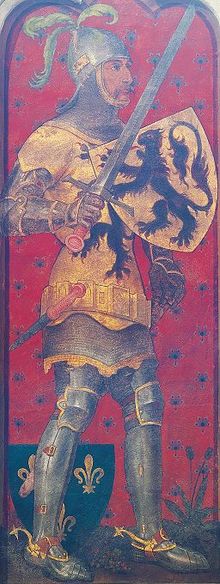Louis I, Count of Flanders
Louis I, Count of Flanders | |
|---|---|
 Louis I, Count of Flanders | |
| Born | c. 1304 |
| Died | 26 August 1346 Battle of Crécy |
| Noble family | House of Dampierre |
| Spouse(s) | Margaret I, Countess of Artois |
| Father | Louis I, Count of Nevers |
| Mother | Joan, Countess of Rethel |
Louis I (c. 1304 – August 26, 1346, ruled 1322–1346) was Count of Flanders, Nevers and Rethel.
History
He was the son of Louis I, Count of Nevers, and Joan, Countess of Rethel, and grandson of Robert III of Flanders.[1] He succeeded his father as count of Nevers and his grandfather as count of Flanders in 1322. He inherited the county of Rethel from his mother.
In 1320 Louis married Margaret, second daughter of King Philip V of France and Joan II, Countess of Burgundy, who would later inherit her mother's counties of Burgundy and Artois in 1361.[2] This marriage alliance made him break with the anti-French policy of his grandfather Robert III and great-grandfather Guy I.[2]
His pro-French policies and excessive taxations levied by Louis caused an uprising in 1323. Beginning as a series of scattered rural riots, the peasant insurrection escalated into a full-scale rebellion that dominated public affairs in Flanders for nearly five years until 1328. The rebels, led by Nicolaas Zannekin, captured the towns of Nieuwpoort, Veurne, Ieper and Kortrijk. In Kortrijk, Zannekin was able to capture Louis himself. In 1325 the King of France, Charles IV intervened whereupon Louis was released from captivity in February 1326 and the Peace of Arques was sealed. The peace didn't last long and soon hostilities erupted again which made the count flee to France. Louis was able to convince his new liege Philip VI of France to come to his aid and Zannekin and his adherents were decisively defeated by the French royal army in the Battle of Cassel.
When the Hundred Years War started, Louis remained steadfast in his French policy, even with the county being economically dependent on England. His actions resulted in an English boycott of the wool trade which in turn sparked a new insurrection under Jacob van Artevelde. In 1339 the count had to flee his lands, never being able to return. Louis was killed at the Battle of Crécy in 1346.[3]
Family
He and Margaret had one son:
- Louis II of Flanders (1330–1384), who succeeded him
Ancestry
| Family of Louis I, Count of Flanders | ||||||||||||||||||||||||||||||||||||||||||||||||||||||||||||||||||||||||||||||||||||||||||||||||||||||||||||||||||||||||||||||||||||||||||||||||||||||||||||||||||||||||||||||||||||||||||||||||||||||||||||||||||||||||||||||||||||||||||||||||||||||||||||||||||||||||||||||||||||||||||||||||||||||||||||||||||||||||||||||||||||||||||||||||||||||||||||||||||||||||||||||||||||||||||||||||||||||||||||||||||||||||||||||||||||||||||||||||||||||||||||||||||||||||||||||||||||||||||||||||||||||||||||||||||||||||||||||||||||||||||||||||||||||||||||||||||||||||||||||||||||||||||||||||||||||||||||||||
|---|---|---|---|---|---|---|---|---|---|---|---|---|---|---|---|---|---|---|---|---|---|---|---|---|---|---|---|---|---|---|---|---|---|---|---|---|---|---|---|---|---|---|---|---|---|---|---|---|---|---|---|---|---|---|---|---|---|---|---|---|---|---|---|---|---|---|---|---|---|---|---|---|---|---|---|---|---|---|---|---|---|---|---|---|---|---|---|---|---|---|---|---|---|---|---|---|---|---|---|---|---|---|---|---|---|---|---|---|---|---|---|---|---|---|---|---|---|---|---|---|---|---|---|---|---|---|---|---|---|---|---|---|---|---|---|---|---|---|---|---|---|---|---|---|---|---|---|---|---|---|---|---|---|---|---|---|---|---|---|---|---|---|---|---|---|---|---|---|---|---|---|---|---|---|---|---|---|---|---|---|---|---|---|---|---|---|---|---|---|---|---|---|---|---|---|---|---|---|---|---|---|---|---|---|---|---|---|---|---|---|---|---|---|---|---|---|---|---|---|---|---|---|---|---|---|---|---|---|---|---|---|---|---|---|---|---|---|---|---|---|---|---|---|---|---|---|---|---|---|---|---|---|---|---|---|---|---|---|---|---|---|---|---|---|---|---|---|---|---|---|---|---|---|---|---|---|---|---|---|---|---|---|---|---|---|---|---|---|---|---|---|---|---|---|---|---|---|---|---|---|---|---|---|---|---|---|---|---|---|---|---|---|---|---|---|---|---|---|---|---|---|---|---|---|---|---|---|---|---|---|---|---|---|---|---|---|---|---|---|---|---|---|---|---|---|---|---|---|---|---|---|---|---|---|---|---|---|---|---|---|---|---|---|---|---|---|---|---|---|---|---|---|---|---|---|---|---|---|---|---|---|---|---|---|---|---|---|---|---|---|---|---|---|---|---|---|---|---|---|---|---|---|---|---|---|---|---|---|---|---|---|---|---|---|---|---|---|---|---|---|---|---|---|---|---|---|---|---|---|---|---|---|---|---|---|---|---|---|---|---|---|---|---|---|---|---|---|---|---|---|---|---|---|---|---|---|---|---|---|---|---|---|---|---|---|---|---|---|---|---|---|---|---|---|---|---|---|---|---|---|---|---|---|---|---|---|---|---|---|---|---|---|---|---|---|---|---|---|---|---|---|---|---|---|---|---|---|---|---|---|---|---|---|---|---|---|---|---|---|---|---|---|---|---|---|---|---|---|---|---|---|---|---|---|---|---|---|---|---|---|---|---|---|---|---|---|---|---|---|---|---|---|---|---|---|---|---|---|---|---|---|---|---|---|---|---|---|---|---|---|---|---|---|---|---|---|---|---|---|---|---|---|---|---|---|---|---|---|---|---|---|---|
| ||||||||||||||||||||||||||||||||||||||||||||||||||||||||||||||||||||||||||||||||||||||||||||||||||||||||||||||||||||||||||||||||||||||||||||||||||||||||||||||||||||||||||||||||||||||||||||||||||||||||||||||||||||||||||||||||||||||||||||||||||||||||||||||||||||||||||||||||||||||||||||||||||||||||||||||||||||||||||||||||||||||||||||||||||||||||||||||||||||||||||||||||||||||||||||||||||||||||||||||||||||||||||||||||||||||||||||||||||||||||||||||||||||||||||||||||||||||||||||||||||||||||||||||||||||||||||||||||||||||||||||||||||||||||||||||||||||||||||||||||||||||||||||||||||||||||||||||||
References
- ^ David M Nicholas, Medieval Flanders, (Taylor & Francis, 1992), 442.
- ^ a b William H. TeBrake, A Plague of Insurrection: Popular Politics and Peasant Revolt in Flanders, 1323-1328, (University of Pennsylvania Press, 1993), 47.
- ^ David Nicolle, Crécy 1346: Triumph of the Longbow, (Osprey, 2000), 13-14.
